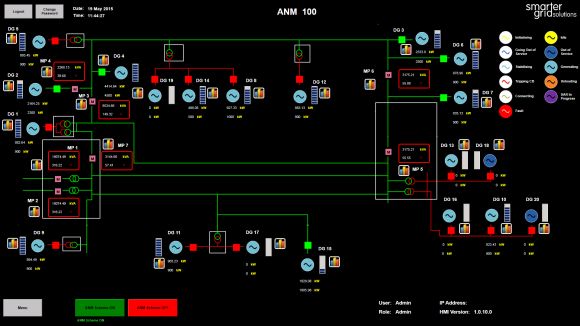Greentech Media’s second-annual Grid Edge Live conference starts today, giving us an opportunity to highlight one of the companies seeking to master the integration of distributed energy, from the microgrid scale on up.
Over the past few years, U.K.-based startup Smarter Grid Solutions has been putting its software into play to balance the ups and downs of intermittent wind and solar power on constrained U.K. grids. Using behind-the-meter energy resources like batteries, combined heat-and-power systems, and remote-controlled water heaters, combined with grid devices like capacitor banks and voltage regulators, SGS is now managing moment-by-moment grid balancing across systems carrying roughly 120 megawatts of renewable energy, in projects stretching from Scotland’s Orkney Islands to the heart of London.
That makes it one of the largest providers of distributed energy resource management software (DERMS) out there, at least in its home country. Now the University of Strathclyde spinout has been picked by the U.S. Department of Energy to test its software at Boulder, Colo.’s National Renewable Energy Laboratory (NREL).
It’s one of five projects announced last week for testing at NREL’s Energy Systems Integration Facility (we’ll be highlighting some of the others later this week) and an important move into North America for the U.K.-based startup.
But it’s not the company's first. Over the past 18 months, SGS has landed work with New York utility Consolidated Edison, southeastern utility Southern Co., and Ontario, Canada-based utility PowerStream.
Each utility plans to use SGS’ software to study the technical feasibility of adding more renewable energy to their distribution grids, starting at the microgrid level. GTM Research has defined a microgrid as an independently operable part of the distribution network, including distributed energy sources, loads and network assets, that is controlled within clearly defined geographical boundaries and can operate in grid-connected or islanded mode.
Since its 2008 funding, SGS has raised £3.5 million ($5.8 million) in venture and public investment, is generating about £4.5 million ($7 million) in annual revenues, and now employs about 60 people, with offices in Glasgow, London and New York City. About one-third of the company’s revenues come from feasibility studies and consulting, often on behalf of renewable energy developers looking for an analysis of their project’s impact on the grid at large, according to CTO and co-founder Bob Currie.
But SGS also provides distribution utilities a technical solution to these renewable integration challenges, which is where its DERMS platform comes in. The company's Active Network Management software offers what the company calls a "unique combination of real-time, autonomous, deterministic control" through a combination of hardware installed at individual sites, a communications network to tie them together, and an open-source software suite that manages them in concert.
The first piece, dubbed SGS Connect, is a digital controller that “sets up the device we’re controlling, whether it’s a battery, a tap changer, a wind turbine or solar generator,” Currie said. Each of these devices is connected in real time through a variety of utility telecommunications options -- “If you name a technology, we’ve probably used it -- digital radios, RF mesh, telephone lines, fiber, GPRS."
From there, the system “figures out what each participating DER needs to do…and then controls the DER autonomously, while also reporting constantly to the control center,” he said. “We can automate all that to happen in a very secure and mission-critical system.”
Most of the time, these controls aren’t needed, he noted. “It’s when that capacity isn’t there when we go into action,” he said. “Our system only has to act for small percentages of the year. But when you need it, you need it to be very fast, autonomous and reliable.”

“We’ve got this working in the U.K. at scale, and it’s delivering real benefits,” he added.
The company's Orkney Islands deployment, for example, has allowed about 28 megawatts of wind power to be interconnected, without the £30 million ($47 million) grid upgrade that otherwise would have been required by utility Scottish Power Energy Networks. Another distribution utility, U.K. Power Networks, has been able to cut solar and wind interconnection costs by up to 80 percent to 90 percent using similar principles.
In some ways, SGS and other DERMS providers are providing distribution-grid-scale replications of the larger-scale grid-balancing efforts that have allowed grid operators like ERCOT or utilities like Xcel Energy to integrate a growing share of wind power into their operations. This kind of real-time integration of customer-sited and utility-controlled systems is still a rarity in terms of real-world grid operations, according to Omar Saadeh, GTM Research analyst and author of the Distributed Energy Resource Management Systems 2014 report.
SGS is “one of the few companies, including Spirae and Enbala, that have actually implemented distributed utility DERMS platforms,” he said. “To date, most North American utility DERMS activity has been focused on load flexibility, typically in the form of emergency and economic demand response. However, the proliferation of distributed generation is changing the business landscape.”
DERMS technology faces a number of challenges in orchestrating the constant adjustment of multiple distributed energy assets, Currie noted. First, they need accurate data to model the grids they’re seeking to balance. Then, they need constantly updated data to reflect ever-changing conditions.
The startup’s project with NREL is studying how these principles can be applied to systems that may not have always-on telemetry to control them, such as smart-home devices, as well as campus microgrids and distribution network devices, he said.
“What if we just establish routines and objectives for devices in the smart home, and they’re just responding to voltage on the network, or values up the feeder that it refers to occasionally. […] How much real-time response do we need? What’s the impact of that on the systems upstream?" said Currie.
The goal is to see how these systems can work together to increase the grid’s hosting capacity for renewable energy. The industry advisory board working with SGS on its grid integration use cases includes NRG Energy and SolarCity, two important players on the distributed energy front; utilities Con Ed, National Grid and Iberdrola USA; the New York State Smart Grid Consortium; and Austin, Texas’ Pecan Street Project.
SGS’ project with NREL will be using computer simulations of various operating conditions, but it also has access to ESIF’s real-world test grid to bring “hardware into the loop,” said Currie.
As utilities around the world start to look for new ways to incorporate DERs into their everyday grid operations, big grid vendors like General Electric, Siemens, Schneider Electric and Toshiba are starting to build this kind of DER integration into their advanced distribution management systems. SGS’ software is designed to integrate with systems like these, Currie said -- but it doesn’t require them to start doing its work.
“I think many people take the kind of top-down approach to these things. You hear a lot of people talking about the application suites for the control center, the modeling challenges, the optimization issues. We don’t start from the top down; we start at the middle and the bottom up -- feeder by feeder, substation by substation.”



